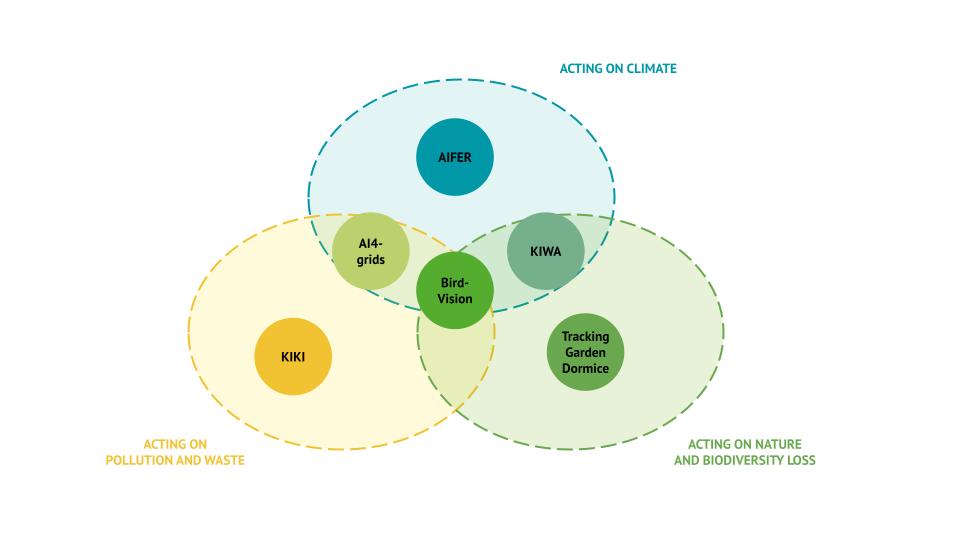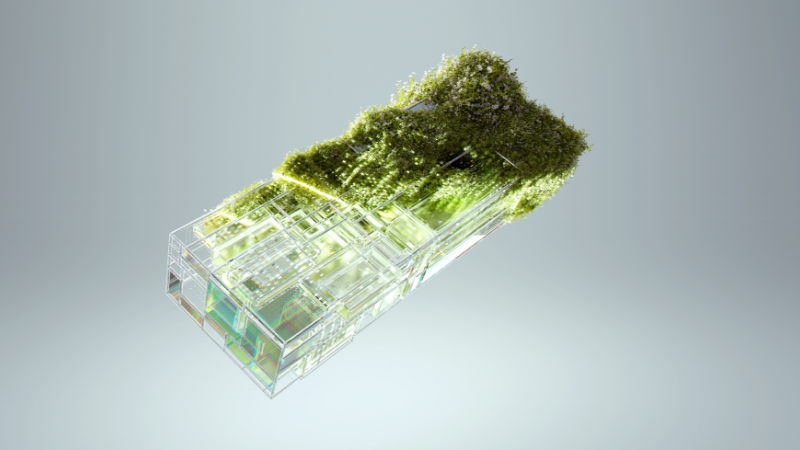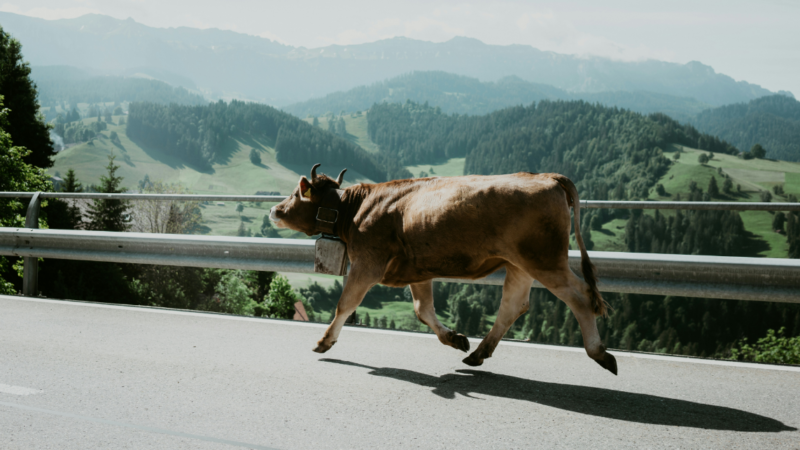Making sense of our connected world

One small part of many – AI for environmental protection
From flying drones to garden dormice: What is the role of AI in applications for better environmental protection? And in what contexts is it being used? This blog post takes a look at six innovative German projects that are developing AI for environmental protection. They show that AI is not always the same, but can be used in a wide variety of ways for a more sustainable future.
AI and the environment: a long-standing issue
The question of the extent to which the use of AI can contribute to the environment is currently attracting a lot of attention in research and civil society. Already in 2019, the Federal Environment Agency published a short study on “Artificial intelligence in the environmental sector”. In particular, the growing amount of environmental data available makes it necessary to use data science and AI applications to process this data. In this context, AI expert Sally Radwan defines three global environmental crises on behalf of the UN Environment Programme: pollution and waste, the climate emergency, and biodiversity and nature loss. Based on these three crises, we present six projects from Germany. They are using AI systems in an attempt to help mitigate and adapt to the crises.
According to an article by Cowls et al. from 2021, there are two main expectations for AI applications in the field of environmental crises: First, a better understanding of the problem, and second, more effective options for action. However, according to Cowls et al., AI systems that pursue sustainability goals often only work on a small scale. Furthermore, according to another article by Heilinger et al. from 2023, these systems are often still in the development phase. Additionally, AI systems themselves consume energy and resources. This means that a realistic assessment of outcomes and consequences is hardly possible and is highly context-dependent. There is little agreement on the extent to which AI is actually helping to achieve sustainability goals, for example, and where AI applications are contributing to complex obstacles.
The following projects must also be viewed in this context. However, they can give an initial impression of where AI systems, embedded in other structures, can be helpful.

Underground AI: how technology is helping to protect our sewers
Putrid rubbish and air filled with exhaust fumes: Pollution and waste have far-reaching effects. For example toxic pollution and health risks that often affect vulnerable groups much more severely. However, not all waste is as visible as trash on the pavement. In case of the KIKI project, the source of the pollution is not even visible to the public eye. KIKI stands for AI in sewer maintenance, where Computer Vision is used to maintain sewers and prevent leaks by identifying potential damage, which can then be inspected and, if necessary, repaired by humans. This could make it easier to maintain and avert leaks in Germany’s 540,723 kilometers of sewers and would prevent wastewater from escaping into the environment. Leaks can, for example, contaminate drinking water. The August-Wilhelm Scheer Institute worked on the project together with the Entsorgungsverband Saar for two years until July 2023.
Interconnected rescue: AI-assisted situation assessment for disaster relief
Increasingly frequent severe weather events, heatwaves and storms show that the effects of climate change are already here and cannot be conjured away with a hyped new technology. However, AI can at least help in dealing with severe weather events. It can also help integrate renewable energies into the electricity grids.
In the AIFER project, the German Aerospace Center is developing a system that uses AI to assess the situation for emergency services in the event of a disaster. Data from satellites, drones, aircraft and social networks is linked for this purpose. This also shows what the system can do and what makes it useful: It enables the automated evaluation and consolidation of a wide range of different data – for example, combining drone images with social media messages. In 2022, the system was already tested during a major civil protection exercise and found to be helpful.
Power grid in focus: AI solutions for renewable energies
Renewable energy sources are often criticized for their intermittent power supply, which makes them difficult to integrate into power grids. This is precisely where the AI4grids project comes in. It develops and combines various AI systems to monitor the electricity grid, identify potential bottlenecks, predict future capacity utilization and ultimately offer solutions to these problems. The project ended in December 2023 with an international symposium at which the algorithms were implemented in a proof-of-concept laboratory.
Wind power and wildlife: BirdVision in action
Renewable energies are an issue where measures to combat the climate crisis and to protect biodiversity are often pitted against each other – for example, birds killed by wind turbines. It is becoming clear that the three crises identified by Radwan are interrelated and that possible measures can have an impact on the other crises. The BirdVision project was initiated in order to avoid pitting climate action against biodiversity protection. It aims to protect birds around wind turbines in the future. To this end, the wind power company has developed a system that uses CV to “detect” birds in the vicinity of wind turbines and stops the turbine if the birds are in danger of flying into the turbine.
Heatmap AI: Early detection and fighting of forest fires
This is not the only link between the climate crisis and the loss of nature and biodiversity. One consequence of the climate crisis is the increase in dry periods and droughts, which increase the probability, number and intensity of forest fires. In particular, large and severe forest fires have a negative impact on existing nature and biodiversity. But the earlier fires are detected and the better they are monitored, the more precisely they can be fought. This is what KIWA, an AI-based forest monitoring system, does. The best way to observe large fires is from above. KIWA uses aerial images collected during drone flights to identify potential danger spots, fires and smoke across a wide area with the help of CV. The aim is to integrate the system into existing processes in order to provide municipalities, civil protection organizations and fire brigades with a basis for rapid responses. Ideally, information on tree species at risk from forest fires should also be embedded for prevention purposes. The project will run until the end of 2025.
Tracking the trail: How AI detects garden dormice
AI applications are not always about the really big things. Sometimes it’s also about the little things, like garden dormice. This endangered species is the most widespread in Germany and is therefore considered a species of responsibility. An important step in protecting populations is to locate their habitats. In the Tracking Garden Dormice project, for example, this is being done with the help of a citizen science collection of sightings of garden dormice. In addition, a specially trained AI recognizes animal sounds to identify garden dormice and record their occurrence. It will help to identify which recordings contain garden dormice. The BUND project in collaboration with the Justus Liebig University Giessen will run until the end of September this year.
Conclusion
The AI projects described help to maintain infrastructures, improve coordination and assess situations faster and with different data sources. They show that there is not one big artificial intelligence that can do everything. Rather, there are many different small applications that do not necessarily have to contain AI technology in order to work.
None of the projects presented describe AI as the solution, but always as one part of a possible solution. It is not a question of hyping artificial intelligence as a technology that will “solve” the climate crisis. Rather, it is about developing useful applications where they are needed. It should be remembered that AI applications in themselves are not sustainable. However, they can be used for sustainable purposes if they are embedded in many other structures. Nevertheless, this must not negate the responsibility to phase out fossil fuels and stand up for social justice.
References
Andersen, I. (2023). Action to tackle the triple planetary crisis. https://www.unep.org/news-and-stories/speech/action-tackle-triple-planetary-crisis
August-Wilhelm-Scheer Insitut (n.d.). KIKI. https://www.aws-institut.de/research/kiki-ki-basierte-kanalinstandhaltung/ (Retrieved on 18.03.2024)
BirdVision (n.d.). https://birdvision.org/ (Retrieved on 18.03.2024)
BMBF (2020). AIFER: Künstliche Intelligenz zur Analyse und Fusion von Erdbeobachtungs- und Internetdaten zur Entscheidungsunterstützung im Katastrophenschutz. https://www.sifo.de/sifo/de/projekte/querschnittsthemen-und-aktivitaeten/kuenstliche-intelligenz-in-der-zivilen-sicherheitsforschung/aifer-kuenstliche-intelligenz–tuetzung-im-katastrophenschutz/aifer-kuenstliche-intelligenz–tuetzung-im-katastrophenschutz_node.html (Retrieved on 18.03.2024)
BUND (2023). KI im Naturschutz. https://www.bund.net/themen/aktuelles/detail-aktuelles/news/ki-im-naturschutz/
Cowls, J., Tsamados, A., Taddeo, M., & Floridi, L. (2021). The AI Gambit — Leveraging Artificial Intelligence to Combat Climate Change: Opportunities, Challenges, and Recommendations (SSRN Scholarly Paper ID 3804983). Social Science Research Network. https://doi.org/10.2139/ssrn.3804983
Heilinger, J., Kempt, H. & Nagel, S. K. (2023). Beware of sustainable AI! Uses and abuses of a worthy goal. AI And Ethics (Print). https://doi.org/10.1007/s43681-023-00259-8
HTWG – Hochschule Konstanz Technik, Wirtschaft und Gestaltung (n.d.). Forschungsprojekt Ai4Grids. https://www.htwg-konstanz.de/hochschule/projekte/ai4grids/ueber-ai4grids/ (Retrieved on 18.03.2024)
Jetzke, T., Richter, S., Ferdinand, J.-P., & Schaat, S. (2019). Künstliche Intelligenz im Umweltbereich. Umweltbundesamt, 42.
ZUG (2023). KI-basierte Waldüberwachung – Künstliche Intelligenz zur Früh-Detektion von Waldbrand-Ereignissen. https://www.z-u-g.org/foerderung/ki-leuchttuerme-fuer-umwelt-klima-natur-und-ressourcen/projekt/kiwa/
This post represents the view of the author and does not necessarily represent the view of the institute itself. For more information about the topics of these articles and associated research projects, please contact info@hiig.de.

You will receive our latest blog articles once a month in a newsletter.
Digitalisation and sustainability
Artificial intelligence and society
Escaping the digitalisation backlog: data governance puts cities and municipalities in the digital fast lane
The Data Governance Guide empowers cities to develop data-driven services that serve citizens effectively.
Online echoes: the Tagesschau in Einfacher Sprache
How is the Tagesschau in Einfacher Sprache perceived? This analysis of Reddit comments reveals how the new simplified format news is discussed online.
Opportunities to combat loneliness: How care facilities are connecting neighborhoods
Can digital tools help combat loneliness in old age? Care facilities are rethinking their role as inclusive, connected places in the community.






